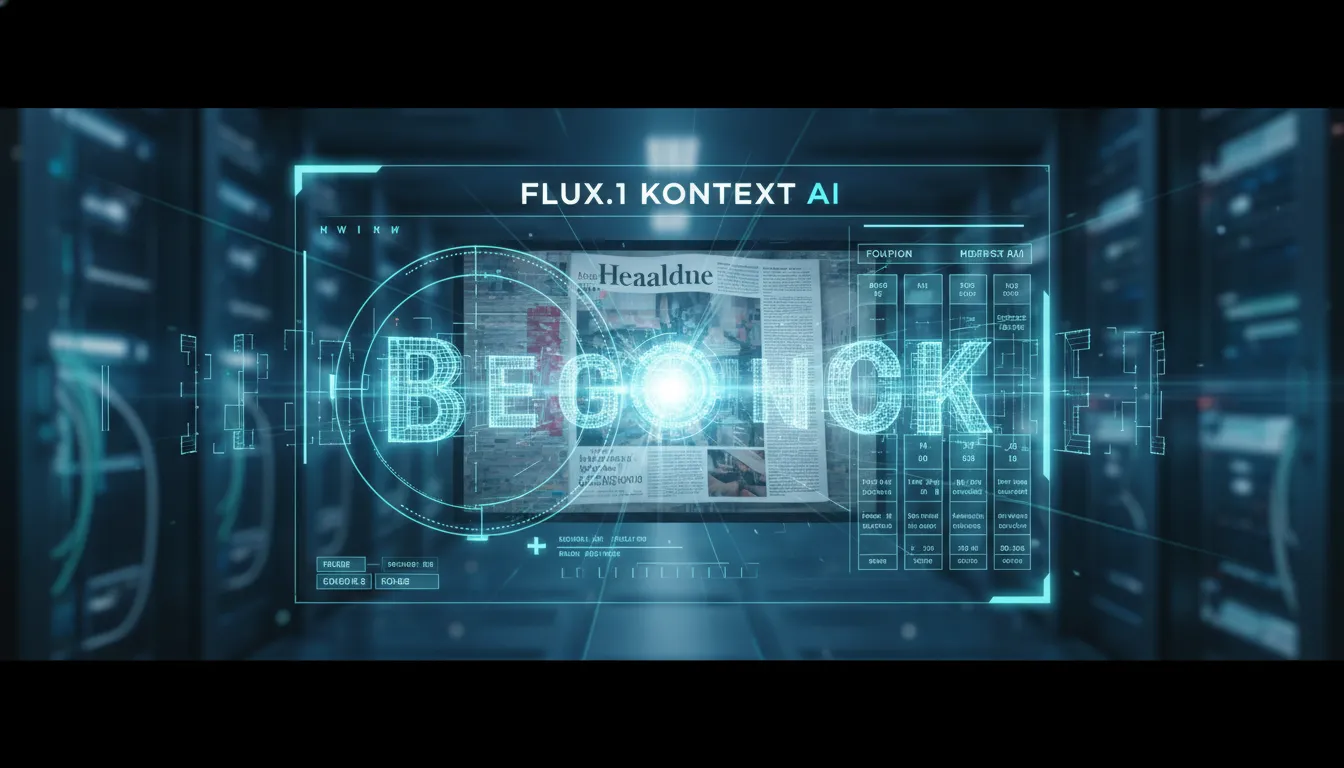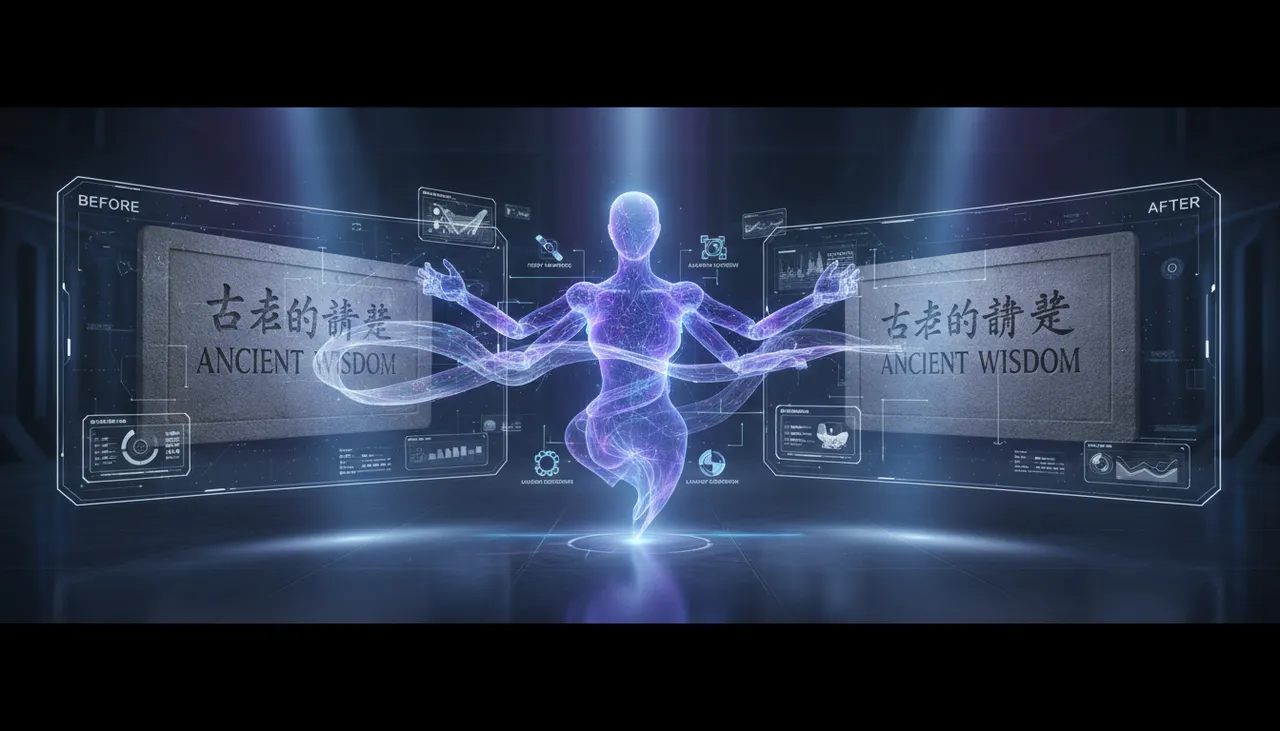AI Typography Generator — Professional Text Rendering with Flux.1 Kontext & Qwen Image Edit
Typography has always been at the heart of visual communication — it’s where language meets design.
But until recently, AI image generation struggled to handle one of the hardest creative tasks: accurate and aesthetic text rendering.
That’s now changing. With models like Flux.1 Kontext and Qwen Image Edit, Createimg.ai introduces a new era of AI typography generation — where fonts, layout, and artistic composition align intelligently to produce human-quality results.
No more distorted letters, broken kerning, or unreadable fonts.
AI typography now feels like design — precise, expressive, and fast.
The Power of Flux.1 Kontext — Smart Typography Design

In the world of AI image generation, making text look real has always been a challenge. Most models either blur the letters or distort them beyond recognition — consistent typography was nearly impossible. Flux.1 Kontext changes that.
What Is Flux.1 Kontext?
Flux.1 Kontext, developed by Black Forest Labs, is a multimodal AI model capable of understanding both images and textual context. It doesn’t just generate visuals — it comprehends the structure of text within an image, enabling precise text editing, style preservation, and layout consistency.
In short, Kontext is like having an AI typographer who actually understands design.
Why It Excels at Font and Layout Design?
1.Accurate Text Replacement
Kontext can identify and replace text in existing images with remarkable precision. For example:
Replace “FOR SALE” with “SOLD,” keeping the same font style, lighting, and perspective.
The result looks completely natural — perfect for brand visuals, packaging updates, UI screenshots, or marketing graphics.
2.Consistent Layout and Style
When you’re working on a campaign series, product packaging set, or multiple key visuals, Kontext maintains font weight, spacing, and composition balance across all versions. Your entire visual system stays stylistically unified.
3.Stable Multi-Round Editing
While most models break formatting after a few tweaks, Kontext stays reliable even through multiple rounds of edits. You can refine headlines, spacing, or text position interactively — without losing design integrity.
4.Open-Source Integration for Production
Flux.1 Kontext also offers a developer (dev) version, open-sourced for integration with tools like Diffusers or ComfyUI. This makes batch text replacement and automated layout generation possible within your own production pipeline.
How to Make Text Look “Real” with Kontext
1.Crafting Effective Prompts
Good prompts help Kontext understand not just what to change, but how to keep it consistent.
Focus on three essentials:
- What to change: Replace “COFFEE” with “CAPPUCCINO.”
- What to preserve: Keep same font family, weight, and kerning.
- Visual constraints: Preserve neon glow and perspective.
This ensures the new text feels fully integrated into the design.
2.Using Reference Images
Upload a reference visual that contains your desired typography or composition, then instruct:
“Replace the subtitle with ‘…’ but keep the same style.”
Kontext detects the proper region and replaces only the text, leaving the rest of the layout untouched.
3.Parameters and Workflow
A balanced configuration is typically 30–60 inference steps and a guidance scale around 3.5.
Use a two-step workflow for best results: 1.Layout Stage: Focus on alignment, spacing, and baseline accuracy. 2.Detail Stage: Add texture, material, glow, or depth refinements afterward.
This structured approach creates realistic, readable, and visually stable typography.
Practical Use Cases
- Ad & Poster Updates: Modify headlines while preserving design fidelity.
- Product Labels: Update ingredient lists or quantities without breaking layout.
- Signage & UI Text Fixes: Correct spelling, brand names, or messages seamlessly.
- Style Unification: Generate consistent variants across multiple visuals or languages.
Prompt Templates You Can Use Right Away
Poster Headline Replacement
Replace the headline with “[New Text],” keep the same font family and kerning, preserve 3D texture and lighting, and maintain center alignment with
the original line height.
Packaging Label Update
Change the label text to “[Ingredients/Net Weight],” keep condensed sans-serif style, tight tracking, and printed texture.
Multilingual Variant
Replace the subtitle with “[Translated Text],” match font weight and baseline, and keep the background grain and shadow.
Flux.1 Kontext elevates AI image generation beyond visuals — it understands the logic and aesthetics of typography.
Whether you’re a brand designer, e-commerce creator, or visual content maker, it empowers you to go from text prompt to polished graphic in minutes. The future of typography design may no longer rely on manual layout and endless exports.
With Kontext, a single sentence is all it takes — the AI already understands your design intent.
Qwen Image Edit: When AI Truly Understands Typography and Layout

In the world of AI image generation, very few models can actually read and edit text naturally.
Most tools create beautiful visuals, but once typography is involved, the results become distorted, blurry, or completely redrawn.
That’s where Qwen Image Edit changes the game — it’s one of the first AI models that truly understands font structure, layout balance, and visual harmony.
What is Qwen Image Edit?
Developed by Alibaba DAMO Academy, Qwen Image Edit is a powerful AI model built specifically for image editing — not just painting over pixels, but understanding and modifying structured elements such as text, fonts, colors, lighting, and layout.
What makes it stand out is its ability to:
- 🔠 Edit both Chinese and English text (add, remove, or replace).
- 🎨 Preserve the original font style, size, color, material, and shadows.
- 📐 Understand both semantics (what you want to say) and appearance (how it should look).
In other words, Qwen Image Edit doesn’t just change text — it edits it like a real designer.
Why It Excels at Typography and Font Design?
1.Replace Text Without Breaking the Style
Say you tell it:
Replace “FOR SALE” with “SOLD,” keeping the same metallic font and perspective.
Qwen Image Edit analyzes the original letterforms — thickness, spacing, shading, and depth — then replaces the content seamlessly.
The result feels authentic, making it perfect for posters, packaging, and branded visuals.
2.Excellent Support for Chinese Characters
Unlike many Western-centric AI tools, Qwen Image Edit handles Chinese text gracefully. It can modify Chinese headlines, slogans, or small labels while keeping the strokes, structure, and overall typography intact.
3.Layout Consistency You Can Trust
It doesn’t just change text; it respects alignment, white space, and hierarchy. If you update a headline but want the layout balance untouched, Qwen Image Edit automatically adjusts font size and kerning to maintain visual harmony.
4.Ideal for Iteration and Workflow Integration
The model supports quick, multi-round editing. You can tweak a few words, adjust colors, or re-render variations — without “breaking” the design. It even integrates smoothly with ComfyUI or Diffusers for semi-automated batch updates across design series.
How to Generate “Real-Looking” Text with AI
1.Craft a Clear Prompt
Good prompts tell the model exactly what to change and what to keep:
Replace the billboard headline with “Createimg.Ai 2025”,
keep the original font family, weight, spacing, and metallic texture,
preserve lighting and perspective.
Key elements to include:
- What to replace.
- Which visual traits to preserve.
- Which elements must remain unchanged (e.g. logo or background).
2. Use Reference Images Upload your brand’s poster or template as a style reference:
“Use this image’s typography as a style reference.”
Qwen Image Edit will detect the existing layout and replace text while maintaining the original design.
. Workflow Tips
Two-Step Editing Process 1. Replace text and confirm structure/alignment. 2. Then refine color, material, and lighting details.
To prevent distortion, add negative prompts such as:
“no warped text, no inconsistent font, no duplicate letters.”
Real-World Use Cases
| Scenario | How to Use It | Result |
|---|---|---|
| Brand Visual Updates | Replace headlines, change campaign year | Consistent font style across visuals |
| Packaging Labels | Update ingredients or net weight | Keeps original print texture |
| Multilingual Designs | Create Chinese/English versions | Aligned and balanced layout |
| UI Screenshots | Edit button text or menu labels | Seamless integration with interface |
Each use case highlights Qwen Image Edit’s core advantage: edits that look invisible.
Prompt Templates You Can Use
Poster Title Replacement
Replace the main title with “[New Tagline]”, keep the same font family, tracking, and 3D bevel effect, maintain original alignment and lighting.
Packaging Label Update
Change the label text to “[Ingredients / Net Weight]”, keep the condensed sans-serif style, tight spacing, and printed texture.
Multilingual Variant
Replace the subtitle with “[Translated Text]”, match the original font weight and baseline, keep background texture unchanged.
Qwen Image Edit elevates AI from a “graphic generator” to a true design collaborator. It understands the relationship between words, composition, and aesthetics — enabling effortless, professional-grade typography editing.
Whether you’re updating brand slogans, translating packaging, or fine-tuning visual layouts, Qwen Image Edit keeps everything consistent, clean, and on-brand.
If Flux.1 Kontext is the creative stylist who defines your visual tone, Qwen Image Edit is the typography specialist ensuring every letter fits flawlessly.
AI typography is not about replacing designers — it’s about removing friction between imagination and output. Flux.1 Kontext defines the structure; Qwen Image Edit ensures accuracy. Together, they produce typography that’s not only beautiful but also functional and language-aware.
Experience this new creative frontier with Flux.1 Kontext and Qwen Image Edit on Createimg.ai — and design lettering that speaks louder than words.
✨ Try it free → https://createimg.ai/ai-models/flux-1-kontext
